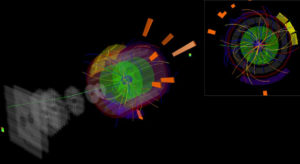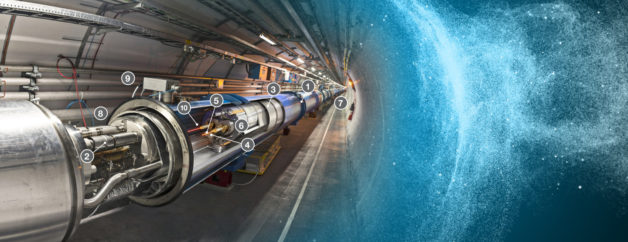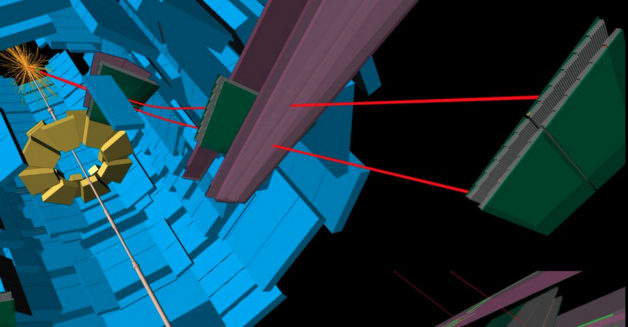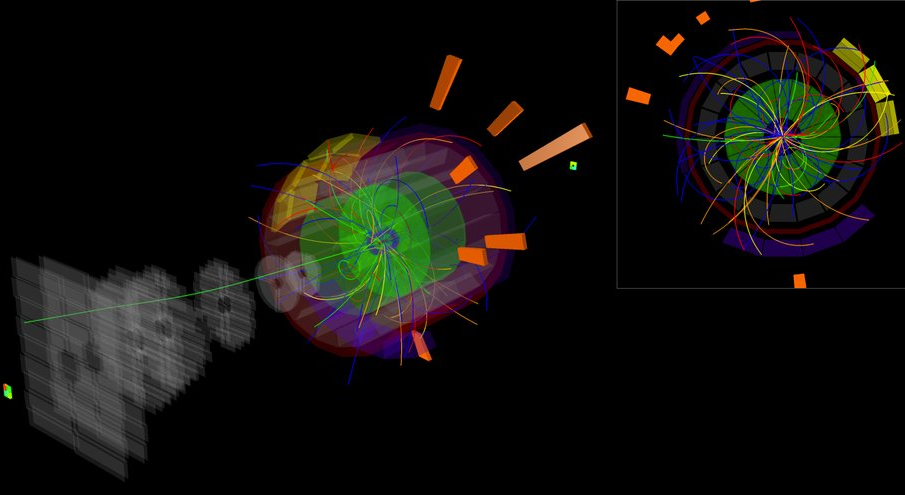
A computerized representation of a proton-proton collision captured by the ALICE detector during the latest commissioning phase of CERN’S LHC, with low-intensity beams. (Credit: CERN)
The most powerful particle accelerator in the world, CERN’s Large Hadron Collider (LHC), is getting up to speed again after its annual winter break. After a switch-on in March and a period of fine-tuning, operators are ramping-up the intensity of LHC’s high-energy beams toward the peak that will generate up to 1 billion particle collisions per second and deliver up to about six times more data than in 2015.
Scientists at the Department of Energy’s Lawrence Berkeley National Laboratory (Berkeley Lab) are among the thousands of LHC collaborators worldwide who will be sifting through loads of new data expected from this latest experimental run, which could reveal unexpected twists in the makeup of matter and shed more light on the known pantheon of particles including the Higgs boson, discovered in 2012.
“Berkeley Lab physicists on the LHC’s ATLAS (A Toroidal LHC Apparatus) experiment are eagerly anticipating the large increase in data that this 2016 run will bring,” said Ian Hinchliffe, who leads Berkeley Lab’s ATLAS group. “Researchers are working on searches for new physics that will use this data and make major improvements in existing searches for supersymmetry”—a theory that proposes for every known particle there is a yet-to-be-observed heavier “superpartner.”
During the first six months of this experimental run the LHC will be used to study collisions of protons, the positively charged particles at the hearts of atoms, followed by a one-month period exploring collisions of lead ions and protons.

A photo illustration showing components of CERN’s Large Hadron Collider (LHC). Click here for a detailed view of the components. (Credit: CERN)
Berkeley Lab’s current ATLAS group has about 40 members, and a group of about a dozen Berkeley Lab scientists work on ALICE (A Large Ion Collider Experiment), another of the four largest-scale experiments at the LHC ring. Staff from Berkeley Lab’s Physics, Nuclear Science, Computational Research, and Engineering divisions, and from its National Energy Research Scientific Computing Center (NERSC) contribute to ATLAS and ALICE, with duties ranging from data analysis to research and development to maintenance and operations. NERSC is a DOE Office of Science User Facility.
“The four-week run of collisions of protons with lead ions, scheduled for the end of the year, is of particular interest to ALICE,” said Peter Jacobs, a senior scientist in Berkeley Lab’s Nuclear Science Division (NSD) who is a part of the ALICE collaboration.
“These experiments will allow us to probe deep into the structure of strongly interacting matter, and to explore strongly-interacting thermodynamics in new ways,” Jacobs said.
In upcoming work, Berkeley Lab researchers will play a leading role in a planned 2019 upgrade to a particle-tracking system for ALICE, which will help build an ATLAS tracking detector that will be installed in the coming decade. Scientists and engineers at Berkeley Lab are also collaborating with CERN on the next-generation of high-field magnets for an upgrade to the LHC that is expected to increase the volume of particle collisions tenfold.

A rendering of a particle collision in the ATLAS detector at CERN’s LHC, from the commissioning phase of this latest experimental run. (Credit: CERN)
Fabiola Gianotti, CERN director-general, said, “The restart of the LHC always brings with it great emotion,” adding that scientists will seek out “improved measurements of the Higgs boson and other known particles and phenomena,” and also look for new physics.
Scientists will collect and analyze data from the ALICE, ATLAS, CMS and LHCb experiments during this latest LHC run, along with data from three smaller experiments: TOTEM, LHCf and MoEDAL.
LHC experiments have so far identified only a few Higgs bosons, the particles at the center of the 2013 Nobel Prize in Physics. This year, the ATLAS and CMS (Compact Muon Selenoid) collaborations—which announced the discovery of the Higgs boson in 2012—will study it in depth thanks to the higher volume in experimental data.
The Higgs boson was the last puzzle piece in the Standard Model, a theory that offers us the best description of our universe, the fundamental particles it’s made from, and the forces that govern them. But there are still several unanswered questions that this theory doesn’t explain, such as why nature prefers matter to antimatter, or what dark matter is despite it potentially making up one-quarter of our universe.
“In 2015, we opened the doors to a completely new landscape with unprecedented energy. Now we can begin to explore this landscape in depth,” said Eckhard Elsen, CERN’s director for research and computing.
This press release is based on a release issued by CERN: View the CERN release.
View a related press release by Fermi National Accelerator Laboratory.
###
Lawrence Berkeley National Laboratory addresses the world’s most urgent scientific challenges by advancing sustainable energy, protecting human health, creating new materials, and revealing the origin and fate of the universe. Founded in 1931, Berkeley Lab’s scientific expertise has been recognized with 13 Nobel prizes. The University of California manages Berkeley Lab for the U.S. Department of Energy’s Office of Science. For more, visit www.lbl.gov.
DOE’s Office of Science is the single largest supporter of basic research in the physical sciences in the United States, and is working to address some of the most pressing challenges of our time. For more information, please visit science.energy.gov.
